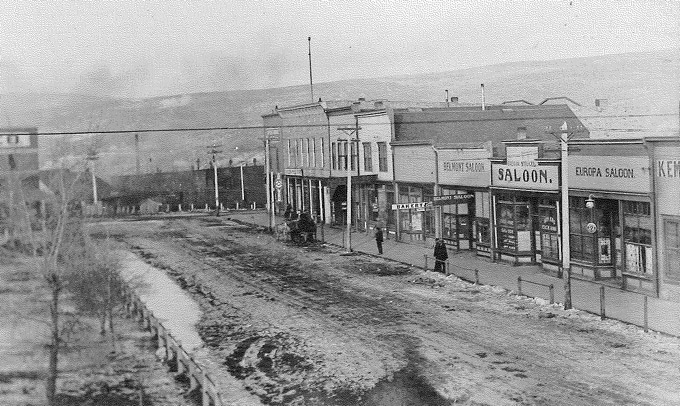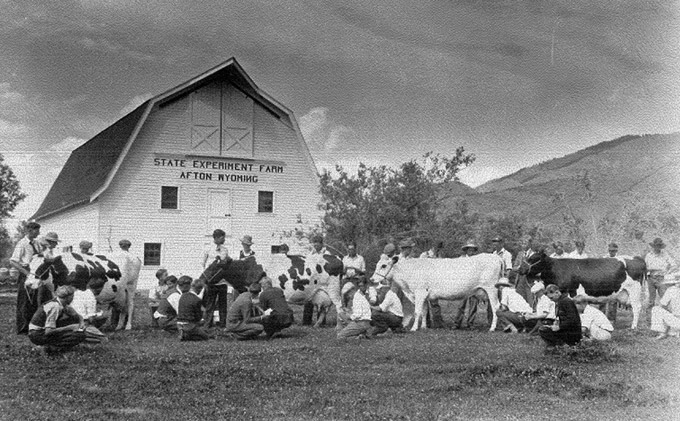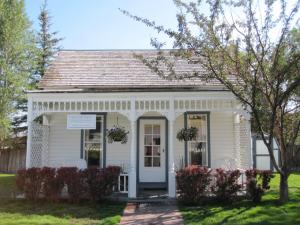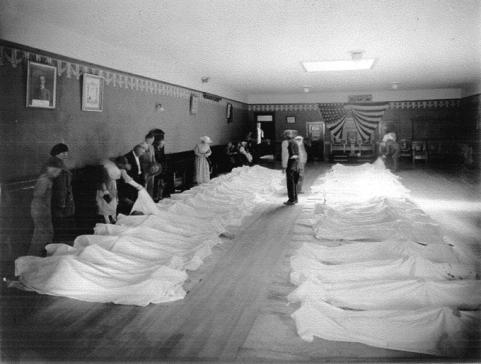- Home
- Encyclopedia
- Lincoln County, Wyoming
Lincoln County, Wyoming
Lincoln County is nestled near the southwest corner of Wyoming. Created in 1911, it emerged from land previously encompassed by Uinta County, which was one of the five original counties of the state. In 1921, Lincoln County was divided, when Sublette and Teton counties were created out of its territory. Named for the nation’s 16th president, Abraham Lincoln, this county borders Utah and Idaho as well as Uinta County to the south, Sweetwater and Sublette counties to the east, and Teton County to the north.
The county spans more than 110 miles from north to south. At its widest, in the southern portion, it’s 50 miles across. It is L-shaped. The narrow, northern strip along the Idaho border includes most of the Wyoming Range, with the highest peak at 11,300 feet. The wider, southern end of the county is high desert and rich in coal, natural gas, and oil. This environmental contrast, between an agricultural, partly forested north and a mostly treeless, industrial south, makes Lincoln County one of the most diverse and complex places in the state.

This environmental diversity resulted from this region being underwater nearly fifty million years ago. For instance, paleontologists have documented the Great Lakes era by examining the rocks and fossils in the Green River Formation, located in the southern portion of Lincoln County. They have discovered that this region contains some of the best-preserved fossils of plant and animal life that predates human beings. Among the millions of fossilized plants, animals, and insects uncovered in the area since the mid-1800s are gars, turtles, palm trees, dragonflies, crayfish, and bats.
To help preserve this region’s prehistory (as well as its natural beauty) the United States government has protected four areas within Lincoln County: Bridger-Teton National Forest, Caribou-Targhee National Forest, Cokeville Meadows National Wildlife Refuge, and Fossil Butte National Monument.
Early History
Before the exploration of the American West by European-Americans, the area of present-day Lincoln County was inhabited by Indians. At this time (pre-1800s), many Americans viewed anything west of the Mississippi River as part of the Great American Desert--land that was largely impassable and not suitable for habitation. Yet, there were thousands of people inhabiting this so-called “vast wasteland”.
According to Errol Jack Lloyd’s master’s thesis, “The History of Cokeville, Wyoming,” before the 1820s the Shoshone were the primary inhabitants of present-day Lincoln County. Whites at the time often referred to this group as Snakes, because they traveled along the Snake River. As with many native tribes, there were numerous sub-groups and linguistic variations within the tribe. Thus, while Shoshone from this region may be closely related, various groups might also be quite distinct from one another.
The Shoshone were primarily a hunting and gathering group before contact with Europeans. According to such archeological evidence as stone obsidian points, chipping grounds, camp sites, firearms, tools and pottery, and oral traditions, these Indians consumed roots and tubers, berries, small game, and insects. The evidence also reveals that given the opportunity, they would occasionally enjoy large game like bear, deer, and buffalo—depending largely on their skill and access to weapons. Before contact with Europeans, this group had relatively little contact with outsiders, including other native tribes.
The introduction of the horse, however, dramatically changed the lives of many native tribes of the high plains and Rocky Mountains. Evidence demonstrates that the Shoshone tribe had horses by the early 1700s. This domesticated creature revolutionized their diet, as well as their exposure to other tribes and cultures.
With horses the Shoshone began exploring more of the region’s land and the availability of water, searching for better hunting and fishing opportunities. In addition, other tribes began making more visits into the region that is now Lincoln County. These contacts occasionally led to conflict.
Fur Trading Era
Early in the 1800s, the fur trade began to expand into the Rocky Mountain West, and mountain men began exploring this region. This occasionally led to conflict between the native tribes and the white fur trappers. For the most part, however, the relationship between mountain men and Indians, especially Shoshone Indians, was friendly.
In 1812, Robert Stuart and a small party traveled from the mouth of the Columbia River in Oregon to St. Louis with dispatches for fur-trade magnate John Jacob Astor. These so-called Astorians had their horses stolen and for a time lost their way among the mountains and valleys of what is now northern Lincoln County. By way of South Pass they finally made their way further east and over the Continental Divide, the first white people known to have used this route.
Former Astorian Donald MacKenzie, exploring for the Northwest Company, trapped furs on the Bear River in this region in 1818 and 1819. By the early 1820s, it is safe to say, American fur trappers visited this region yearly, and continued to do so until the beaver trade died two decades later.
Westward Migration
Beginning in the 1840s, droves of emigrants bound for good land in Oregon, religious freedom in Utah and gold in California began crossing the continent in steadily growing numbers each summer. The Sublette Cutoff, the Lander Cutoff and other branches of the Oregon, Mormon and California trails crossed what’s now Lincoln County.

By the late 1870s, white settlements had emerged throughout present-day Lincoln County, such as the one near Cokeville. In the Bear River valley near the Idaho line, Cokeville was settled when colonizers found copper, phosphate, and coal. Shortly thereafter, settlers brought cattle and sheep into the area. Tilford Kutch, a fur trapper, is credited as the first settler and John W. Stoner, a general store owner, is credited with founding the town. That said, few people thought of this settlement as permanent.
Star Valley, further north, was settled around the same time as Cokeville. The first known white settler there was trapper John Welsh, who with an unnamed companion built a cabin in the valley in 1874. They stayed for only a couple of years. The first permanent settler in the valley was August Leigmburg. He built a house near Stump Creek.
Mass settlement on this region, however, did not begin until 1878 when members of the Church of Jesus Christ of Latter-day Saints arrived from Utah. In 1874, Congress had passed the Poland Act, making it easier for federal officials to prosecute polygamy. This resulted in federal authorities bringing cases against polygamists in Utah, and Mormons searching for more remote areas where they could continue practicing their religion and traditions without persecution.
Thus, many Mormons took up residence in Star Valley, established the town of Afton, and continued practicing polygamy until the turn of the 20th century. Many of these early settlers started dairy farms and creameries in the valley. These early settlers began referring to this region as the “Little Switzerland of America” as it reminded them of the sweeping hills and valleys from their European homelands. Unlike the settlers of the Cokeville area, these people came with every intention of staying.
Formation of Lincoln County
As settlement continued, more rural communities, towns and cities slowly emerged. In 1897, the town of Kemmerer materialized. Kemmerer, currently the county seat of Lincoln County, was founded as a coal town by Patrick Quealy and Mahlon Kemmerer. The town was named for Kemmerer, the primary investor financing early coal exploration of this area. The town was officially incorporated in 1899.

Unlike such nearby coal towns as Frontier and Diamondville, Kemmerer was independent--not operated by a company. As a result, individual lots were purchased by entities other than those involved in the mining industry. Kemmerer became a multi-industry community, relying on the extraction of natural resources, as well as on the raising of livestock. As population in the area continued to increase, Lincoln County was formed in 1911 with Kemmerer, the largest town, chosen as the county seat.
Remarkable Stories
Lincoln County has had some pretty remarkable and unforgettable events throughout its existence. A few are detailed below.
The founder of J. C. Penney & Co., James Cash Penney, opened his first Golden Rule Store in Kemmerer in 1902, and lived there for several years, laying the foundation for what eventually became a retail empire.
In a ranching community, cattle theft is taken quite seriously. It was especially alarming and shocking to discover a woman rustler in southwestern Wyoming in the early 20th century, as it defied gender norms. In 1919 Annie Richey was arrested and convicted of cattle rustling near Fossil, Wyoming, 15 miles west of Kemmerer. Her trial was held in Kemmerer at the county courthouse. Following her conviction, Richey’s lawyers appealed the case, but the Wyoming Supreme Court upheld the conviction. In the meantime, she was released on bond and allowed to return to her ranch. While there, she was poisoned and died. Newspapers speculated she’d been protecting the real rustlers all along, and had been killed by whoever feared she might talk. Her alleged murder was never solved.

The dangers of coal mining became all too real for the people of Frontier and Kemmerer on August 14, 1923, with one of the worst mining tragedies in the state’s history. An explosion occurred in the mine on a day when only 135 of the 250 men employed were working in the mine. Ninety-nine men were killed. Investigators eventually attributed the accident to a fire boss, also killed, who tried relighting his safety lamp with a match. Most of those who survived acted quickly by barricading themselves away from the flames and waiting until rescue teams found them hours later. The towns of Frontier and Kemmerer honored the fallen miners with a joint three-day funeral service. The dead were buried on Friday, Saturday, and Sunday following the event.
In 1986, Cokeville experienced an unforgettable tragedy--a school bombing. On May 16, two Cokeville residents took the children and staff at Cokeville Elementary School hostage. David and Doris Young, a married couple, brought a homemade bomb and a number of guns with them when they entered the building. They herded the 167 hostages into one room. Then, the Youngs demanded a ransom of $300 million. After a two-hour standoff, the bomb exploded, apparently an unintentional occurrence. At that point, David Young shot and killed his wife, shot and wounded a teacher, and fatally shot himself. Seventy-six children were hospitalized for burns and smoke inhalation. There were no other deaths.
Many of the children later recalled that angels protected them from the explosion or helped them get away. These accounts are collected in a book by the Cokeville Miracle Foundation, Witness to Miracles, published 20 years after the event, and in “Survivor is My Name,” a 2012 collection of 14 oral histories produced by the Wyoming Department of State Parks and Cultural Resources.
The story also caught the attention of the national media. The CBS Television Network produced the 1994 TV movie To Save the Children about the incident, and the event was also included in a 1997 episode of Unsolved Mysteries.
Recent History
The primary industries in Lincoln County continue to be mining and ranching, with coal and trona mining, oil and gas production, and natural gas processing dominating in the south near Kemmerer and Diamondville; dairy farming and ranching dominating in the north near Star Valley and Afton; and mining and ranching both continuing in the center near Cokeville.
Tourism is also important to the local economy. Out-of-state hunters and fishermen visit often, and a number of local events likewise aim at attracting tourists, including the FossilFest, Lincoln County Fair and Rodeo, Oyster Ridge Music Festival, and chariot racing. Restaurant and hotel owners often advertise their businesses as rest stops for travelers bound for Jackson, Wyoming or Yellowstone National Park.
Resources
Primary Sources
- “Anna Richey Slain; Brother Held.” Wyoming State Tribune, May 20, 1922, pp. 1, 8. Accessed Sept. 17, 2012 via Wyoming Newspaper Project.
- Antilla, Alice. “First One Hundred Years Coal Mining: Hams Fork-Kemmerer, Lincoln County.”
- Writer's Program of the Work Projects Administration in the State of Wyoming. In Wyoming: A Guide to its History, Highways, and People. American Guide Series. New York: Oxford University Press, 1941.
- “Famous Rustling Case is Closed,” Kemmerer Camera, Oct. 26, 1921, pp. 1, 8. Accessed Sept. 17, 2012 via Wyoming Newspaper Project.
- “Kemmerer Cattle Case is Settled and Woman Guilty,” Rock Springs Rocket, Nov. 28, 1919., p. 1. Accessed Sept. 17, 2012 via Wyoming Newspaper Project.
- Lincoln County Government. "Lincoln County Historical Sites." Accessed September 17, 2012. http://www.lcwy.org/community/History.php.
- Smith, Trish Henderson, Facebook posting to author via Sweet Memories: Research Group, July 5, 2012.
- ________. Facebook posting to author via Sweet Memories: Research Group, August 14, 2012.
- Town of Diamondville Wyoming. "Diamondville: A Diamond in the Rough." Accessed September 17, 2012. http://www.diamondvillewyo.com/.
- United States Department of the Interior. National Park Service. Fossil Butte National Monument. Brochure, 2010.
Secondary Sources
- “A 1986 Hostage Event at a Cokeville, Wyoming Elementary School.” Unsolved Mysteries, Season 9, Episode 43. 1997.
- Barrett, G. Kemmerer, Wyoming: The Founding of an Independent Coal Town, 1897-1902. Kemmerer, Wyo.: Quealy Services Incorporated, 1975.
- Clark, Eva N. Cokeville: Biographies of Her Colonizers, 1870-1900. N.p: 2010.
- Cokeville Miracle Foundation. Witness to Miracles: Remembering The Cokeville Elementary School Bombing. Greybull, Wyo.: Pronghorn Press, 2006.
- Julian, Judy and the Fossil Country Museum. Images of America: Kemmerer. Charleston, S.C.: Arcadia Publishing, 2009.
- Larson, T. A. History of Wyoming, 2nd ed., rev. Lincoln: University of Nebraska Press, 1990.
- Lincoln County Wyoming. "Historical Societies." Accessed July 2012. http://www.lincolncountywy.org/index.html.
- Lincoln County, Wyoming History. Wyoming Genealogy. Accessed July 2012. http://wyominggenealogy.com/uinta/lincoln_county_history.htm
- Lloyd, Errol Jack. “The History of Cokeville, Wyoming.” Master’s thesis, Utah State University, 1970.
- McInnis, Doug. “James Cash Penney: From Clerk to Chain-Store Tycoon.” WyoHistory.org. Accessed July 2012 at /encyclopedia/james-cash-penney-clerk-chain-store-tycoon.
- Moulton, Candy. Roadside History of Wyoming. Missoula, Mont.: Mountain Press Publishing Company, 2012.
- Roberts, Phil. “Frontier Wyoming’s Most Dangerous Occupation: The Quest for Mine Safety in Wyoming’s Coal Industry.” Buffalo Bones: Stories from Wyoming’s Past. Accessed September 17, 2012 at http://uwacadweb.uwyo.edu/robertshistory/coal_safety_buffalo_bones.htm.
- “To Save the Children.” DVD. Directed by Steven Hilliard Stern. CBS Television. 1994.
- Urbanek, Mae. Wyoming Place Names. Missoula, Mont.: Mountain Press Publishing Company, 1988.
- Vasey, Wanda Sims and Dorise Marx Housely, eds. Branches and Twigs. N.p., 1980.
- Wilson, D. Ray. Wyoming Historical Tour Guide: Travel Wyoming and Visit the Historical Places Where Men and Women Worked Together to Shape the Equality State! 2nd ed. Carpentersville, Ill.: Crossroads Communications, 1990. Includes an account of the Anne Richey trial.
- Wixom, Hartt and Judy. Trial by Terror: The Child-hostage Crisis in Cokeville, Wyoming. Bountiful, UT: Horizon Publishers, 1987.
- ________. When Angels Intervene To Save the Children: The Cokeville, Wyoming Bombing Incident. Springville, UT: Cedar Fort Incorporated, 1994.
- Wright, Dorothy, Judy Julian, and Martha Bertot. Kemmerer, Wyoming: Digging for Western History. Greybull, Wyo.: Pronghorn Press, 2007.
- Wright, Dorothy and Norris Tratnik. Echoes of Elkol: The Story of a Western Coal Camp. Greybull, Wyo.: Pronghorn Press, 2004.
- Wright, Dorothy, Norris Tratnik, and Frank Scigliano. Glencoe: Spelling Out Western Coal Camp History. Greybull, Wyo.: Pronghorn Press, 2005.
- Wyoming Genealogy. "Lincoln County, Wyoming History." Accessed July 2010. http://wyominggenealogy.com/uinta/lincoln_county_history.htm.
- Wyoming Office of Tourism. “Wyoming Forever West.” Accessed July 2012. http://www.wyomingtourism.org.
- Wyoming Places. Accessed July 2012. http://wyld.sdp.sirsi.net/maps/.
- Wyoming Recreation Commission. Wyoming: A Guide to Historic Sites. Basin, Wyo.: Big Horn Publishers, 1976.
- Wyoming State Parks and Cultural Resources. "Survivor is my Name,” A compilation of 14 oral histories of the Cokeville bombing. Accessed Sept. 17, 2012. http://wyospcr.state.wy.us/MultiMedia/Index.aspx?mmtypeID=15.
- ________. "State Historic Preservation Office--Lincoln County." Accessed July 2012. http://wyoshpo.state.wy.us/NationalRegister/Search.aspx.
Illustrations
- The photos of Kemmerer in 1913, of Kemmerer people examining bodies after the 1923 coalmine explosion, and of future dairy farmers in Afton in 1932 are from the American Heritage Center at the University of Wyoming. Used with permission and thanks.
- The photos of the J.C. Penney home in Kemmerer, and of the 1889 LDS ward house in Auburn, now property of the Star Valley Historical Society, are by Jessica Clark. Used with permission and thanks.
